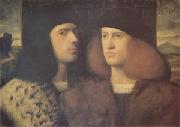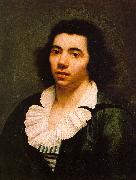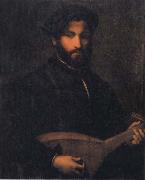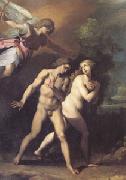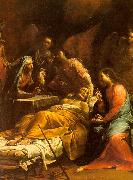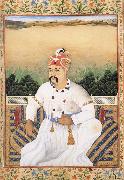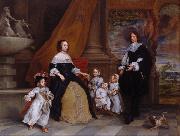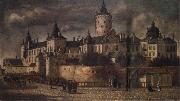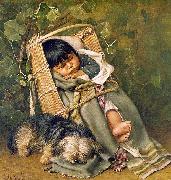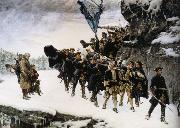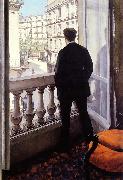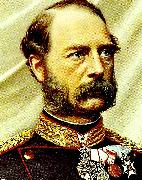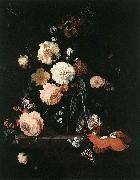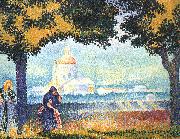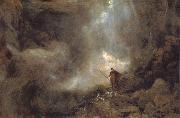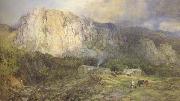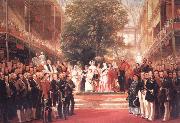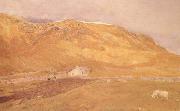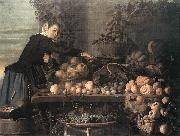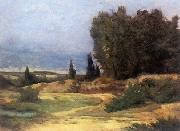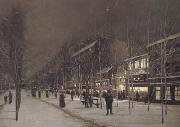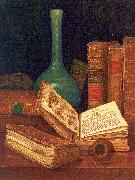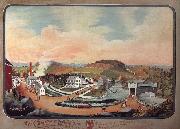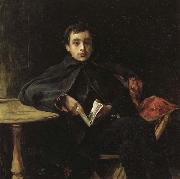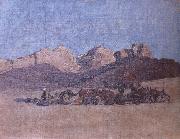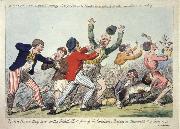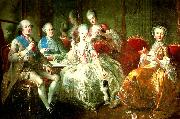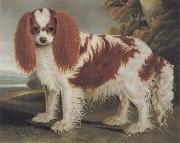|
|
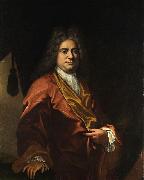 |
Giovanni Camillo Sagrestani
|
|
(1660-1731) was an Italian painter of the Baroque era.
A native of Florence, he was a follower of the style of Carlo Cignani. His major pupil was Matteo Bonechi (1672-1726) and Giovanni Battista Ranieri del Pace. Four canvases attributed to Sagrestani can be found in the church of Santa Maria della Fraternite in Foiano della Chiana. He also executed works in the church of San Frediano in Cestello, in the Oltrarno district of Florence. Paintings in the church of SS. Annunziata in San Giovanni Valdarno are attributed to Sagrestani. An Assumption of the Virgin is found in Nancy. |
|
|
|
|
|
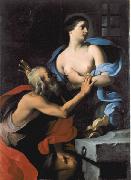 |
Giovanni Domenico Cerrini
|
|
(1609-1681), also called Gian Domenico Cerrini or il Cavalier Perugino, was an Italian painter of the Baroque period, active mainly in Rome and influenced in large part by painter of the Bolognese School.
Born in Perugia, Cerrini initially apprenticed under Giovanni Antonio Scaramuccia, then in 1638 moved into the Roman studio of Guido Reni, but strongly influenced by Lanfranco, Guercino, Domenichino, and Andrea Sacchi. He was patronized by the family of Cardinal Bernardino Spada. Cardinal Giulio Rospigliosi gave him the commission to decorate the cupola of Santa Maria della Vittoria (1654-5). His style has the monumental clarity of Domenichino, but somewhat sapped of vitality.
Paintings of his can be found in many of the churches of Rome, where he died, including Santa Maria in Traspontina, San Carlino alle Quattro Fontane, Chiesa Nuova, San Carlo ai Catinari, Santissimo Sudario dei Piemontesi, SanteIsidoro, as well as in Galleria Colonna, Palazzo Spada, and the Palazzo Corsini art gallery. |
|
|
|
 |
Girolamo da Carpi
|
|
(1501-1556) was an Italian painter and decorator who worked at the Court of the House of Este in Ferrara. He began painting in Ferrara, by report apprenticing to Benvenuto Tisi (il Garofalo); but by age 20, he had moved to Bologna, and is considered a figure of Early Renaissance painting of the local Bolognese School.
He trained in the studio of a local painter who showed the influence of Lorenzo Costa and Raphael. In the 1520s Girolamo visited Rome and Bologna and was inspired by the Mannerist style of Giulio Romano. Geographically and stylistically he straddles the various influences.
He returned to Ferrara and collaborated with Dosso Dossi and Garofalo among others on commissions for the d'Este family. Girolamo became the architect to Pope Julius III in 1550 and supervised the remodeling of the Vatican's belvedere. Returning to Ferrara, he was charged of the enlargements of the Castello Estense.
Da Carpi's paintings include a Descent of the Holy Spirit, in the church of St Francis at Rovigo; a Madonna, an Adoration of the Magi, and a St. Catharine at Bologna; and the St. George and the St. Jerome at Ferrara.
|
|
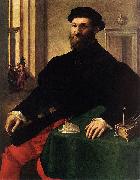 |
Giulio Campi
|
|
(1500 - 5 March 1572) was an Italian painter and architect. His brothers Vincenzo Campi and Antonio Campi were also renowned painters.
The eldest of a family prominent painters, Campi was born at Cremona. His father Galeazzo (1475-1536) taught him the first lessons in art.
In 1522, in Mantua, he studied painting, architecture, and modelling under Giulio Romano. He visited Rome, became an ardent student of the antique, and like Bernardino e distantly related to him e he combined a Lombard and Roman traditions. He collaborated on some works with Camillo Boccaccino, the son of Boccaccio Boccaccino, with whom Campi may also have received training.
Campi is called the "Ludovico Carracci of Cremona" although he preceded the founder of the Eclectics. When but twenty-seven Giulio executed for the church of Sant' Abbondio his masterpiece, a Virgin and Child with Sts. Celsus and Nazarus, a decoration masterly in the freedom of its drawing and in the splendour of its colour. His numerous paintings are grandly and reverently conceived, freely drawn, vigorously coloured, lofty in style, and broadly handled. He was animated in all his work by a deep piety. Numerous of his fresco works are housed in churches of Cremona, Mantua, Milan and in the church of Saint Margaret's, in his native town. Among his chief works are the Descent from the Cross (S. Sigismondo) at Cremona, and the frescoes in the dome of S. Girolamo at Mantua. An altar-piece in S. Sigismondo and his Labours of Hercules were engraved by the celebrated Ghiso, il Mantovano.
He died in Cremona in 1572.
|
|
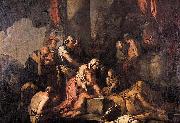 |
Giulio Carpioni
|
|
(1613 - 29 January 1678) was an Italian painter and etcher of the early Baroque era.
Born probably in Venice, Carpioni studied under Alessandro Varotari (il Padovanino) and was also influenced by the work of Simone Cantarini, Carlo Saraceni and Jean Leclerc. He came into contact with Lombard art after a brief visit to Bergamo in 1631. In 1638 he settled in Vicenza and executed most of his work there.
He painted history and bacchanals, and also sacred subjects of a small size, many of which are to be seen in the churches in the Venetian states. Paintings by him may be seen in the Galleries of Augsburg, Dresden, Vienna, Modena, and Florence. He was also an etcher; his best plates being St. Anthony of Padua, Christ on the Mount of Olives, The Virgin reading, and The Virgin with Rosary. He died at Verona. Carlo Carpioni, his son, was also a painter.
Among his important works are the Apotheosis of the Dolfin family (1647) and the Allegory of the Grimani Family (1651), and altarpiece of Sant'Antonio da Padova, a Virgin and two saints, and a Triumph of Silenus in the Gallerie dell Accademia of Venice. He painted a series of canvases for the Oratory of San Nicola da Tolentino in Vicenza.
|
|
|
|
|
|
 |
Giuseppe Cades
|
|
(December 8, 1750 - December 8, 1799) was an Italian sculptor, painter, and engraver.
Judgment of Solomon, Royal Academy of Arts, London.He was born in Rome. He studied under Mancini and Domenico Corvi, gaining a prize in 1765 with his picture of Tobias recovering his Sight. He visited Florence in 1766, and two years later executed an altar-piece for San Benedetto in Turin and in 1771 another for the Santi Apostoli. He also decorated the Palazzo Chigi with frescoes, landscapes, and scenes from Tasso. He has left two etchings, Christ blessing Little Children and The Death of Leonardo da Vinci. He died in Rome. |
|
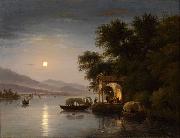 |
Giuseppe Canella
|
|
(28 July 1788 - 11 September 1847), also referred to as Giuseppe Canella the Elder, was an Italian painter.
Initially trained by his father Giovanni, an architect, fresco painter and set designer, Giuseppe Canella started out producing stage sets and decorating stately homes in Verona and Mantua. It may have been under the influence of Pietro Ronzoni, a landscape painter of international renown active in Verona, that he took up landscape. The first views were not produced until 1815, after a short stay in Venice. After making his debut at the Esposizione di Belle Arti di Brera of 1818, he made a long journey through Spain, the Netherlands and France for study purposes. The set of 13 landscapes shown at the Esposizione di Belle Arti di Brera in 1831 proved a great success with the public and critics alike, not least due to the fame achieved in Paris with works exhibited in the Salons, commissions from Louis Philippe of Orleans and the award of a gold medal in 1830. He returned to Milan in 1832 and devoted his energies to urban views characterised by an interest in the events of contemporary life and an atmospheric form of portrayal in evident competition with Giovanni Migliara. Landscape came to predominate as from 1835 with subjects drawn from the Lombard countryside and lakes. The focus on poor and humble aspects of life formed part of the artistes fundamental naturalism and coincided with a moralistic approach derived from the novelist Alessandro Manzoni. Crucial importance attaches in the artistes mature period to his trip to Rome and Naples in 1838-39.
|
|
|
|
|
|
|
|
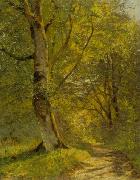 |
Godfred Christensen
|
|
(23 July.1845 - 15 November 1928) was a Danish landscaoe painter. He belonged to the transition between Romanticism and Realism. studied at the Royal Danish Academy of Fine Arts in Copenhagen from 1860 to 1867. |
|
|
|
|
|
|
|
|
|
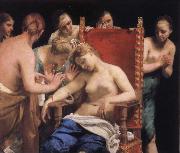 |
Guido Cagnacci
|
|
(January 19, 1601 - 1663) was an Italian painter of the late-Baroque period, belonging to the Forle painting school and to the Bolognese School.
Born in Santarcangelo di Romagna near Rimini, he died in Vienna in 1663. He worked in Rimini from 1627 to 1642. After that, he was in Forle, where absorbed the lesson of the Melozzo's painting.
Prior to that he had been in Rome, in contact with Guercino, Guido Reni and Simon Vouet. He may have had an apprenticeship with the elderly Ludovico Carracci. His initial output includes many devotional subjects. But moving to Venice under the name of Guico Baldo Canlassi da Bologna, he renewed a friendship with Nicolas Regnier, and dedicated himself to private salon paintings, often depicting sensuous naked women from thigh upwards, including Lucretia, Cleopatra, and Mary Magdalene.This allies him to a strand of courtly painting, epitomized in Florence by Francesco Furini, Simone Pignoni and others. In 1650, he moved to Venice. In 1658, he traveled to Vienna, where he remained under patronage of the emperor Leopold I.
His life was at times tempestuous, as characterized by his failed elopement (1628) with an aristocratic widow. Some contemporaries remark him as eccentric, unreliable and of doubtful morality. He is said to have enjoyed the company of cross-dressing models. |
|
|
|
|
|
|
|
|
|
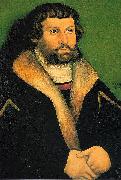 |
Hans Cranach
|
|
(ca. 1513-1537), also known as Johann Lucas Cranach, was a German painter, the oldest son of Lucas Cranach the Elder. German art historian Christian Schuchardt, who discovered his existence, credits him with an altar-piece at Weimar, signed with the monogram "H. C.", and dated 1537. He died at Bologna in 1537. Luther mentions his death in his "Table Talk", and Johann Stigel, a contemporary poet, celebrates him as a painter.
|
|
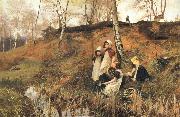 |
Hector Caffieri
|
|
British,the New Water Colour Society which later became the Royal.1847-1832
|
|
|
|
|
|
|
|
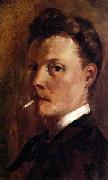 |
Henri-Edmond Cross
|
|
(May 20, 1856 - May 16, 1910) was a French pointillist painter.
Cross was born in Douai and grew up in Lille. He studied at the École des Beaux-Arts. His early works, portraits and still lifes, were in the dark colors of realism, but after meeting with Claude Monet in 1883, he painted in the brighter colors of Impressionism. In 1884, Cross co-founded the Societe des Artistes Independants with Georges Seurat. He went on to become one of the principal exponents of Neo-Impressionism. He began his Pointillist period after spending time with Paul Signac in 1904. His later works are Fauvist, perhaps influenced by his acquaintance with Henri Matisse.
His final years, plagued by rheumatism, were spent in Saint-Clair[disambiguation needed ], where he died in 1910. His pieces include The Church of Santa Maria degli Angely Near Assisi (1909) and Landscape with Stars.
The Allen Memorial Art Museum (Oberlin College, Ohio), the Block Museum of Art (Northwestern University, Illinois), The Art Institute of Chicago, the Fine Arts Museums of San Francisco, Harvard University Art Museums, the Hermitage Museum, the Honolulu Academy of Arts, Kröller-Meller Museum, the Los Angeles County Museum of Art, the Metropolitan Museum of Art, Museum of Grenoble (Grenoble, France), Musee d'Orsay (Paris), Musee Malraux (Le Havre, France), Musee Richard Anacreon (Granville, France), the Museum of Modern Art (New York City), the National Gallery of Art (Washington D.C.), New Art Gallery (Walsall, England), the Tel Aviv Museum of Art and the Thyssen-Bornemisza Museum (Madrid), are among the public collections holding works by Henri-Edmond Cross.
|
|
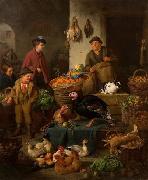 |
Henry Charles Bryant
|
|
(1835 - 1915) was a popular painter of portraits and landscapes specialising in farmyard and market scenes which were noted for their great attention to detail. He worked mainly in London and exhibited frequently between 1860 and 1880 at the Royal Academy, the British Institution and the Royal Society of British Artists. His paintings are highly sought after today.He died at 49, Derby Road, Portsmouth in January, 1915(Obituary:- Hampshire Telegraph & Post, January 8, 1915).
|
|
|
|
|
|
|
|
|
|
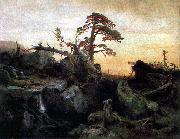 |
Hermann August Cappelen
|
|
(1 May 1827 - 8 March 1852) was a Norwegian painter. Cappelen was best known for his melancholic, dramatic and romantic landscape compositions.
Hermann August Cappelen was born in Skien, Norway. He was the son of Diderik von Cappelen (1795-1866) and Margaret Noble Severine Henriette Løvenskiold (1796-1866). Both the Løvenskiold and Cappelen families were prominent Norwegian family of merchants, land owners, civil servants and politicians. His family were the owners of prominent iron works and various other properties. His grandfather, Diderik von Cappelen (1761-1828), was member of the Norwegian Constituent Assembly at Eidsvoll in 1814.
He grew up at Holden, a manor in Ulefoss in the Grenland district of the county of Telemark. After school graduation in Skien in 1845, he went to Christiania to take another exam at the University of Oslo. He subsequently went to Dusseldorf, where he studied with Hans Gude. Cappelen was a student at Kunstakademie Dusseldorf under Johann Wilhelm Schirmer in landscape painting class (1846-1850). |
|
|
|
|
|
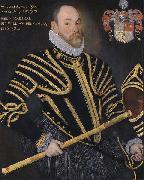 |
Hieronimo Custodis
|
|
(also spelled Hieronymus, Heironimos) (died c. 1593) was a Flemish portrait painter active in England in the reign of Elizabeth I.
A native of Antwerp, Custodis was one of many Flemish artists of the Tudor court who had fled to England to avoid the persecution of Protestants in the Spanish Netherlands.He is thought to have arrived in England sometime after the fall of Antwerp to the forces of the Duke of Parma in 1585.
Three English portraits by Custodis signed and dated 1589 firmly establish him as resident in London by that year. Sir Roy Strong attributes a portrait of Sir Henry Bromley dated 1587 to Custodis, suggesting an earlier arrival, and has verified the recent attribution of a portrait of the young Edward Talbot dated 1586 to Custodis.In 1591, he was living in the parish of St Bodolph-without-Aldgate where "Jacobus the son of Ieronyme Custodis A Paynter" was baptised on 2 March. He is assumed to have died in 1593, as all of his known works are dated between 1589 and 1593, and his widow remarried that year.
Custodis's unsigned but dated works are idenitified by "palaeographical peculiarities" in the inscriptions which can be closely matched to those in his signed portraits.
|
|
|
|
|
|
|
|
|
|
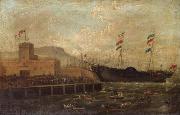 |
Hugh Carroll Frazer
|
|
(February 22, 1891 - July 9, 1975) was born in the Martinsburg, West Virginia. He graduated from the United States Naval Academy in 1912. He received the Medal of Honor for actions at the United States occupation of Veracruz, 1914. Frazer was a World War I veteran. |
|
|
|
|
|
|
|
|
|
|
|
|








